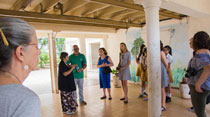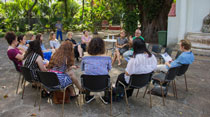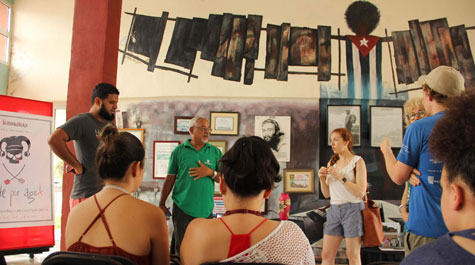Students visit Cuba to study how globalization has impacted education
William & Mary students participating in a study-abroad program in Cuba the week after Commencement got an up-close look at the education system in that nation, as well as its history and culture.
A small group of students from various majors went on the excursion, which was an offshoot of the COLL 300 credit-eligible class Globalization and Education.
“Even if students were well traveled, this was a unique experience because Americans have been isolated from Cubans for a protracted period of time,” said Jacqueline Rodriguez, W&M assistant professor of education and co-organizer of the trip.
The group visited a primary school and secondary school, spoke with a representative of the ministry of education and talked with local residents during visits to Vinales and the Bay of Pigs. It also toured the Museum of Fine Arts, the Museum of the Revolution, the Jimenez Foundation, the UNSECO biosphere reserve at Las Terrazas and the Korimacao Community Project.
“We knew that few people have been able to visit Cuban K-12 schools and have an audience with a representative of the Cuban Ministry of Education,” Rodriguez said. “To be so warmly welcomed in the primary and secondary schools we visited was a tremendous opportunity for the students.”
 W&M students met students in the schools, toured classes and did a Q&A with Cuban students and teachers who spoke English. Their research questions related to early childhood education, Cuba’s universal pre-K program and literacy programming, as well as access to higher education from rural areas.
W&M students met students in the schools, toured classes and did a Q&A with Cuban students and teachers who spoke English. Their research questions related to early childhood education, Cuba’s universal pre-K program and literacy programming, as well as access to higher education from rural areas.
“The candid dialogue that took place between our group and the Cuban teachers and students included the sharing of mutual experiences and challenges,” Rodriguez said. “For example, we are both experiencing significant challenges related to teacher retention and teacher professional development.
“Technology and access to the internet was another challenge the Cuban schools currently face, which U.S. schools, especially those with limited resources, including rural schools, also face. Throughout our visits, it was made clear that schools were a galvanizing mechanism to keep the interests of the revolution relevant.”
Cuban teachers shared with W&M students their experiences of what it was like to go back to school, or to be enticed by the tourism industry to leave teaching or to choose to stay in it.
“For me, the most valuable part of the trip was getting to interact with the everyday Cuban citizens that we met,” said Diana Weyandt ’18. “From our kind hosts, to members of the Committee for the Defense of the Revolution, to artists and shopkeepers we met wandering the streets of Havana, everyone was friendly and welcoming and genuinely wanted to make sure that we had a positive experience in Cuba.
“Not only were people eager to share their Cuban culture, they also wanted to know about our lives and perspectives. The individuals we met truly made this trip a great cultural exchange.”
 Gabrielle Pachon ’18 said the most meaningful part of the trip for her was getting a better understanding of Cuban culture and ideologies.
Gabrielle Pachon ’18 said the most meaningful part of the trip for her was getting a better understanding of Cuban culture and ideologies.
“It was extremely eye opening going to El Museo de Revolución and the Playa Girón Museum,” Pachon said. “Even though the museums' material was controversial, I think I got a better understanding of how and why the Cuban government and people believe certain ideologies and hold the government up in such high esteem.”
She and two other students had an eye-opening moment when they spoke with a local resident in his store about the pre-primary education program. They were able to review the educational materials that are given to mothers throughout their pregnancies until the children can attend school.
“It was astounding to hear how the government actually monitors children's education before they get to school,” Pachon said. “The father seemed very happy with the program and was very excited to show us the programs. I think moments like this, where we were able to talk with locals and get a less ‘polished’ view of the country, were really special.”
Jacob Sims, senior manager of sustainable development programs at AidData and trip co-coordinator, said an unanticipated benefit of being in a culture so inherently distinct from American influence was the intensive opportunity for critical reflection.
“Spending a week in a culture and on a tour heavily influenced by the Cuban government's perspective was an excellent opportunity for the students to practice thinking critically about the validity of the information provided to them,” Sims said.
“And not just the overt, explicit 'propaganda' coming from the Cuban government, but also the more subtle, implicit biases inherent to our culture — perspectives on individual liberty and politics and community we take as a given in the U.S. but only really show one side of the coin. It was inspiring to grow with the students as we all grappled with these issues and developed in our thinking about comparative models of education.”















